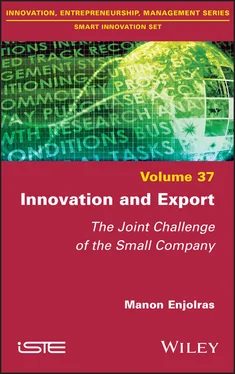9 References
10 Index
11 End User License Agreement
1 v
2 iii
3 iv
4 ix
5 x
6 xi
7 xii
8 xiii
9 xiv
10 xv
11 xvi
12 xvii
13 xviii
14 1
15 3
16 4
17 5
18 6
19 7
20 8
21 9
22 10
23 11
24 12
25 13
26 14
27 15
28 16
29 17
30 18
31 19
32 20
33 21
34 22
35 23
36 24
37 25
38 26
39 27
40 28
41 29
42 30
43 31
44 32
45 33
46 34
47 35
48 37
49 38
50 39
51 40
52 41
53 42
54 43
55 44
56 45
57 46
58 47
59 48
60 49
61 50
62 51
63 52
64 53
65 54
66 55
67 56
68 57
69 58
70 59
71 60
72 61
73 62
74 63
75 64
76 65
77 66
78 67
79 69
80 70
81 71
82 72
83 73
84 74
85 75
86 76
87 77
88 78
89 79
90 80
91 81
92 82
93 83
94 84
95 85
96 86
97 87
98 88
99 89
100 90
101 91
102 92
103 93
104 94
105 95
106 96
107 97
108 98
109 99
110 100
111 101
112 102
113 103
114 104
115 105
116 106
117 107
118 108
119 109
120 110
121 111
122 112
123 113
124 114
125 115
126 116
127 117
128 118
129 119
130 120
131 121
132 122
133 123
134 124
135 125
136 126
137 127
138 128
139 129
140 130
141 131
142 132
143 133
144 134
145 135
146 136
147 137
148 138
149 139
150 141
151 142
152 143
153 144
154 145
155 146
156 147
157 148
158 149
159 150
160 151
161 152
162 153
163 154
164 155
165 157
166 159
167 160
168 161
169 162
170 163
171 164
172 165
173 166
174 167
175 168
176 169
177 170
178 171
179 172
180 173
181 174
182 175
Smart Innovation Set
coordinated by
Dimitri Uzunidis
Volume 37
Innovation and Export
The Joint Challenge of the Small Company
Manon Enjolras

First published 2021 in Great Britain and the United States by ISTE Ltd and John Wiley & Sons, Inc.
Apart from any fair dealing for the purposes of research or private study, or criticism or review, as permitted under the Copyright, Designs and Patents Act 1988, this publication may only be reproduced, stored or transmitted, in any form or by any means, with the prior permission in writing of the publishers, or in the case of reprographic reproduction in accordance with the terms and licenses issued by the CLA. Enquiries concerning reproduction outside these terms should be sent to the publishers at the undermentioned address:
ISTE Ltd
27-37 St George’s Road
London SW19 4EU
UK
www.iste.co.uk
John Wiley & Sons, Inc.
111 River Street
Hoboken, NJ 07030
USA
www.wiley.com
© ISTE Ltd 2021
The rights of Manon Enjolras to be identified as the author of this work have been asserted by her in accordance with the Copyright, Designs and Patents Act 1988.
Library of Congress Control Number: 2021945495
British Library Cataloguing-in-Publication Data
A CIP record for this book is available from the British Library
ISBN 978-1-78630-620-3
This book is drawn from the work of a French doctoral thesis on the topic “Methodology for analyzing the innovation and export capabilities of manufacturing and process SMEs: identification and characterization of a common space with a view to developing a multi-criteria decision support tool”, conducted between 2013 and 2016 at the ERPI laboratory of the University of Lorraine (located in France). They were financially supported by the UIMM, the F2I, the Lorraine regional council as part of the PRINCIP research chair as well as the InnovENT-E initiative of excellence (IDEFI). This thesis has paved the way for new research projects that also feed this book. They have themselves benefited from the support of the CNRS and the University of Lorraine (PEPS Mirabelle CIIPME project), as well as the Lorraine University of Excellence Initiative of the PIA2 from the French government (ANR-15-IDEX-04-LUE).
First of all, I would like to thank the Research Network on Innovation (RNI), as well as the ISTE Group, for giving me the opportunity to publish this book by awarding me the Honoris Causa prize for the promotion of research in the study of innovation. It is a real pride to see our thesis work valued in this way and a great opportunity to continue to develop it within a long-term research project.
I would also like to thank the ERPI laboratory of the University of Lorraine for allowing me to carry out this thesis and for allowing me to build my research path on a daily basis within its team. I would also like to express my gratitude to my two thesis directors, Mauricio Camargo and Christophe Schmitt, without whom none of this would have been possible.
I would like to thank all the practitioners and institutions that agreed to participate, in one way or another, in this work and to devote some of their precious time to it. Thanks to the different laboratories that have been kind enough to welcome me during these last years, allowing me to give an international dimension to this research work: INRPME Trois Rivières, HEG Fribourg, the Industrial Engineering Department of the USACH, the University of San Juan and the National University of Cuyo.
Finally, I would like to warmly thank my family and friends who have always supported me in my projects, both professional and personal.
Innovation and internationalization have been identified as two of the main driving forces of economic growth (Pla-Barber and Alegre 2007; Bołkunow 2019). And while globalization has changed the competitive playing field for all companies, this is especially true for small organizations within which available resources are limited (Etemad 2004; Szczepanski 2016).
The internationalization of a company can take several forms: import, external growth, direct/indirect export, etc. For this research work, we focus on a specific mode of internationalization: exporting. Several studies point out that exporting is one of the most common ways to enter the foreign market in the early stages of SME internationalization (Bianchi and Wickramasekera 2016). Thus, throughout this book, we will define exporting as the internationalization strategy aimed at positioning our products and services outside the geographic boundaries of our home country.
Exporting provides an additional source of demand via a larger market or by enabling the creation of a new market (Monreal-Pérez et al . 2012). In addition, international competitiveness helps boost the domestic market and pushes other companies to internationalize (DiPietro and Anoruo 2006). However, international markets are characterized by much stronger competitive pressure than domestic markets (López et al . 2005). SMEs are thus generally hampered by their difficulties in mobilizing the strategic resources needed to enter and succeed in international markets (Etemad 2004). However, if we look at the main figures on the competitiveness of companies, and more particularly small companies, it appears that despite the difficulties they face, SMEs do export. However, although SMEs employ a large share of the workforce, they are under-represented in global trade relative to their contribution to national economies (OECD 2018), particularly in the industrial sector. Direct exports by SMEs account for only 3% of the total SME manufacturing sales, compared to 14% for large companies (WTO 2016). In contrast, the rate of export participation appears to be clearly correlated with company size. The participation of medium-sized companies 1(59%) is higher than that of micro or small companies 2(9% and 38%) and is quite similar to that of large companies (66%) (WTO in English 2016). Thus, it seems necessary to strengthen export support, particularly for smaller structures by helping them better mobilize and optimize their strategic resources.
Читать дальше













